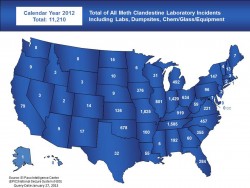Methamphetamine Statistics

Helping Find Treatment Since 2002.
Our caring placement counselors are standing by right now to help you locate a reputable alcohol or drug rehab facility that meets your needs and budget.
Don't struggle alone. Call us now and get the help you need.
Let Us Help - Call Us Now
Methamphetamine is a psychostimulant drug related to amphetamine. Its effects increase a user’s energy level, generate a false sense of well-being, and makes users feel generally hyperactive. The effects of meth last for about 8 hours, after which users experience a significant crash. The crash is associated with feelings of depression, severe mood swings, agitation, and strong cravings to use more meth.
Methamphetamine is a very addictive drug, and its use appears to becoming more and more widespread in the United States. Meth has significant long-term effects, and is known to cause long-term brain damage.
Statistics on Methamphetamine Use in the United States

Methamphetamine use is a large problem across the entire US.
Methamphetamine use is a large problem in the US. In the 1970s and 1980s the drug was largely kept in the west and mid-west, but in the following years the drug made its way east, and it can now be found in most areas of the nation. Meth abuse has a very high cost to society due to loss of productivity, law enforcement costs, health care costs, treatment expenses and more. It’s cost to the individual is enormous.
These statistics show the prevalence of meth use in the US:
- Since 1999 the proportion of Americans using meth on a monthly basis hovered around 0.2 and 0.3 percent. (Drug Policy Alliance)
- Almost 11 million Americans have tried methamphetamine at least once. (Drug Policy Alliance)
- In 2006 young adults aged 18-25 were more likely to use methamphetamine in the past year than youths aged 12 to 17 and adults 26 or older, with 1.6%, 0.7%, and 0.4% respectively. (National Survey on Drug Use and Health)
- Treatment admissions for methamphetamine tripled from 1996 to 2006, from 3% to 9%. (Partnership for a Drug Free World)
- Between 2004 and 2005 people aged 12-17 years old reporting last month usage of meth increased by 4.3% For people aged 18-25 the rate increased by 15.6% between 2002 and 2003, and increased again by 5.8% between 2004 and 2005. (CRS Report for Congress)
Methamphetamine Statistics for American Youth
Methamphetamine use is not confined to the adult population, it affects youth as well. According to a report from the National Institute on Drug Abuse, however, meth use among youth has declined in recent years. These statistics, found in the 2011 report, show the state of youth meth use:
- Approximately 13 million people aged 12 or older have used meth in their lifetimes, with 353,000 being current users in 2010.
- The 2010 Monitoring the Future Survey showed that 8th, 10th, and 12th graders in the US had declining meth use rates between 1999 and 2007, and that the numbers had remained unchanged since then.
- Certain areas have higher rates of meth abuse among youth, notably Hawaii, the West Coast, and the Midwest.
Children of meth users also face significant issues. Methamphetamine abusers have a decreased capacity to care for their children and provide the basic needs for them.
Lab Incidents
Methamphetamine is an entirely synthetic drug which can be produced using some chemicals that are relatively easy to access. Because of this, people across the US and around the world try to make, and sometimes succeed in making, their own meth. Meth production can take place in small, personal labs or in superlabs, which are growing in number in California, according to the Office of National Drug Control Policy. Meth also enters the US from other countries such as Canada and Mexico.
Many of these operations go wrong, however, which can lead to deadly fires and chemical reactions. The number of lab incidents across the US is an indicator of meth use in the nation.
According to data gathered by the US Drug Enforcement Agency, from 2004 to 2007 the number of incidents dropped from 23,829 in 2004 to 6,858 in 2007. They went back up from 2008 to 2010, with 15,196 in 2010. In 2011 and 2012 the numbers again went down modestly. The last year with available data, 2012, showed 11,210 meth lab incidents in the United States.
In 2012, Missouri (1,825), Indiana (1,429), Tennessee (1,585), Kentucky (919), and Illinois (801) were the states with the highest numbers of meth lab incidents, as shown in the parentheses. Methamphetamine lab incidents have been uncovered in all 50 states.
According to the University of Nevada at Reno, for every one pound of methamphetamine produced 5 to 8 pounds of toxic waste are also produced.